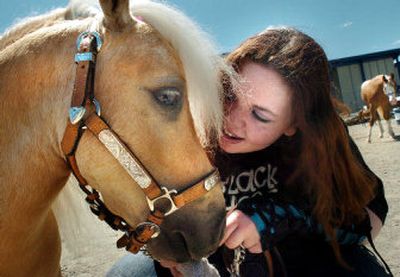Mini horses make poor house pets

A horse is a horse, of course – even if it’s 2 feet tall.
The darlings of European royalty as far back as the 1600s, miniature horses fell out of the lap of luxury with a thud when they were imported to the United States in the 19th century. Becoming true workhorses, they transported coal out of Appalachian mining tunnels that were too small even for Shetland ponies.
In the 1940s, horse folk began to breed these pint-size equines for beauty and consistency instead of subterranean drudgery. And their status as a bona-fide breed was cemented in 1978 with the formation of the American Miniature Horse Association ( www.amha.org).
A miniature horse by definition is no taller than 34 inches at the withers (the last hairs of the mane), and weighs between 150 and 250 pounds. With a life expectancy of 20-plus years, these horses are not dwarfs –which have abnormally short legs and large heads – but rather stylish animals whose proportions are identical to their regular-sized brethren.
One area where they differ dramatically is upkeep.
“A miniature might eat a cup of grain instead of a quart,” says Cathy Fatigati of Laurel Acres Miniature Horses in Allentown, N.J., who has raised these doe-eyed charmers since 1985. “They can get overweight very easily, so you have to be careful how much pasture, or grass, you let them have.”
An acre is adequate for several miniatures, and keeping more than one is advised, as all equines are herd animals. In winter, these horses grow longer, teddy-bear-like coats.
Although Fatigati brings her miniatures into her barn, “a lot of people do have run-in sheds, and as long as they can get out of the weather and wind, they’ll be fine.”
The same can’t be said for their encounters with coffee tables and carpeting.
“People think, `They’re the size of a dog – why not bring them in the house?’ ” says Jenifer Van Deinse of Millstone Farm in Fort Salonga, N.Y., noting that she has clients in the Hamptons who give their miniatures the run of the house. “But they are not house pets. They are horses, and they need to be treated like horses.”
With, of course, the appropriate concessions to size. Miniatures are not meant to be ridden except by the tiniest of children – say, under 70 pounds– and even that is not recommended. Instead, owners can use them for cart-driving, obstacle jumping and pet-assisted therapy.
Though some miniature horses have been used to guide the blind – donning sneakers so they can go into malls and other public places – “that’s a really rare bird,” says Fatigati, not a little ironically. Indeed, The Guide Horse Foundation ( www.guidehorse.org), notes that less than 1 percent of miniature horses are suitable for that work, which includes mastering almost two dozen voice commands and learning to “spook in place” as riot-control horses do.
Van Deinse notes that show-quality miniatures start at $5,000 (with $175,000 the highest recorded auction price), but pets start at $1,000.
Size is one factor that affects cost (any horse over 34 inches cannot be registered with the AMHA), as well as conformation faults such as bad bites.
About 10 years ago, Van Deinse helped the AMHA with a demographic survey. It found that “the typical miniature owner is a woman in her 50s who always wanted horses,” she says. “As they get older, the desire to have a horse is still there, but maybe they don’t want … something that weighs more than a thousand pounds.”
As for temperament, Van Deinse describes miniature horses as “wanting to please, very loving and really smart.”
Miniature horses surged in popularity about a decade ago, when they were “discovered” by nonhorse people and began to be bred indiscriminately. Things have settled down considerably since, but “we have a `puppy-mill problem’ in miniature horses,” Fatigati warns.
To that end, be sure to buy from an established breeder who can articulate his or reasons for a particular breeding.